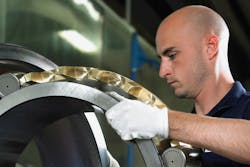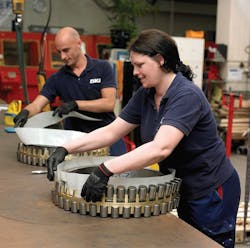While rolling bearings in rotating equipment are engineered to operate over a calculated service life, various adverse influences can jeopardize and prematurely shorten how long a bearing actually will perform properly. Wear, rust, solid particle contaminants and sporadic metal-to-metal contact are among the typical culprits.
Sooner or later, too, material fatigue can be expected to occur, resulting from shear stress cyclically appearing immediately below the load carrying surface of a bearing’s rings and rolling elements. Over time, these stresses cause microcracks underneath the surface, gradually extending to the surface itself. As a bearing’s rolling elements pass over the cracks, fragments of the material break away (known as “spalling”). This is usually the beginning of the end for a bearing.
Workers in the process of remanufacturing bearings
Some operating environments present especially daunting challenges, exemplified by demanding applications such as those in the oil and gas industry. In the case of offshore drilling, for instance, moving into deeper and harsher environments exposes equipment and components to severe extremes in pressure, temperature, contamination and other especially punishing forces. As a result, bearings that ultimately bear the brunt may need to be replaced.
Outright replacement, however, can be expensive and may involve long — and subsequently unproductive — lead times for delivery.
A practical alternative is to apply a controlled remanufacturing process before major bearing damage or failure can occur and then return the bearing to full service.
Cost-benefit analysis shows that significant cost savings may be achieved by remanufacturing a bearing depending on its size, complexity, condition, price and application needs. And, depending on the extent of remanufacturing required, repairing a bearing instead of manufacturing a new one may save up to 90 percent in energy and decrease overall carbon dioxide emissions.
Ultimately, bearing remanufacturing can contribute to decreased total life cycle costs, fully exploited service life, cost savings, improved uptime from increased machine availability, reduced environmental impact in terms of less energy and less scrap, and enhanced asset reliability.
A damaged bearing (left) before remanufacturing. The same bearing (right) after refurbishment.
Rolling out the process
All rolling bearings are candidates for remanufacturing (although it may be economically unwise for extremely small sizes), and the nature and extent of restoration will naturally depend on a particular bearing’s condition and application requirements. In general, during remanufacturing relevant functional surfaces of the bearing will be repaired, including, if necessary, the replacement of bearing components.
Best practices for the job should involve expert bearing analysts who are sufficiently equipped to evaluate the bearing and identify which remanufacturing approach will be the most efficient in restoring the bearing consistent with application requirements. Standard industry procedures and established criteria will guide recommendations and restoration work. And, just as importantly, dedicated remanufacturing service centers should always be enlisted.
Of course, some bearings may need more work than others. As a result, various categories of rework leading to remanufacturing have been developed.
Inspection. This is the first step, whether for a used bearing or for bearings stored over a long period, and it involves comparing them with drawings and/or specification requirements. This process typically includes cleaning, degreasing, disassembling the bearing, nondestructive testing, visual/microscopic inspection and dimensional inspection followed by a detailed bearing analysis report that offers recommendations for appropriate treatment and suitable rework attention.
Reclassification. This procedure encompasses all the operations of inspection in addition to minor repair (buffing and minor polishing of inactive and active surfaces plus grinding of scratches and grooves), demagnetization, reassembly, dynamic testing, lubrication and preservation, and packaging for return to service.
Refurbishment. This category of service builds on inspection and the selected reclassification activities and will include one or more of the following: replacing rolling elements if necessary; remanufacturing the bearing’s cage for the rolling elements or replacing it with an identical cage; interchanging used components (such as seals, snap rings and others); grinding, polishing and/or plating of mounting surfaces as necessary to return to original drawing dimensions of the bearing outside surface and bore; and polishing raceways.
During refurbishment, appreciable material removal takes place, which removes superficial damage and modifies the stressed material volume. The surface is finished to its original blueprint specification. Then, the bearing is refitted with new rolling elements with a diameter equal to the diameter of the elements previously contained in the bearing, plus twice the depth of material removal if clearance requirements demand it. Cages are inspected for cracks and replated if necessary, or replaced with a new one. Usually new rolling elements are placed within the cage, and the bearing is then reassembled.
Remanufacturing. This set of activities will include the previous operations of inspection, reclassification and, where appropriate, refurbishment and extend to one or more of the following activities: grinding, installing a new ring and changing or substituting components to create a different assembly identity (in effect, modifying to improve performance or properties).
During remanufacturing, deeper grinding of inner and outer ring raceways of larger bearings is acceptable. Moreover, further machining methods, such as hard turning, can be applied. Superficial damage is removed, and the stressed material volume is modified. The surface is finished to its original blueprint specification. In some cases for particular bearing types, new rolling elements exceeding the original rolling element diameter may be engineered. This size increase of the rolling elements may require cage pocket reworking or cage replacement.
With such clearly defined procedures, bearings returned to service can meet (or sometimes even exceed) specified standards. After work is completed, final inspection and measurements, cleaning and preservation, service reporting and archiving of documentation should be routinely performed.
Timing is everything
Success in remanufacturing turns on when the bearing is flagged for the process. In some particularly critical industries, it is common practice from a safety perspective to remove rolling bearings during scheduled maintenance or overhaul of equipment regardless of the bearing’s condition, and then perform the rework and return the bearing to service.
Since this is not necessarily the case in all industries, when does a bearing become a legitimate candidate for remanufacturing? The correct timing for bearing removal and rework can be determined to achieve the optimal balance of a long service life and low operating costs.
Predictive maintenance strategies and related condition monitoring technologies offer big assists in detecting early defects and damage, which can signal the early need for intervention and resolution to extend bearing service life. Other related technologies, such as traditional vibration monitoring and lubrication analysis (detecting wear particles), also can be engaged – all in an effort to avoid catastrophic failure of a bearing and the increasingly intensive and costly rework required for totally failed bearings.
In short, bearing damage detected at the earliest possible stage will contribute to a timely and positive remanufacturing outcome at relatively minimal cost. Conversely, when a machine breaks down because of bearing failure, the costs associated with remanufacturing likely will rise, although the process can still be implemented with success.
But despite the potential benefits of remanufacturing, a legitimate question arises whether a restored bearing can truly perform like new when returned to service. Look for remanufactured rolling bearings that come with warranties.
Mark S. Campbell is manager — solution factories south at SKF USA Inc. He can be reached at [email protected] or 205-702-7825. Learn more about SKF USA Inc. at skfusa.com.





